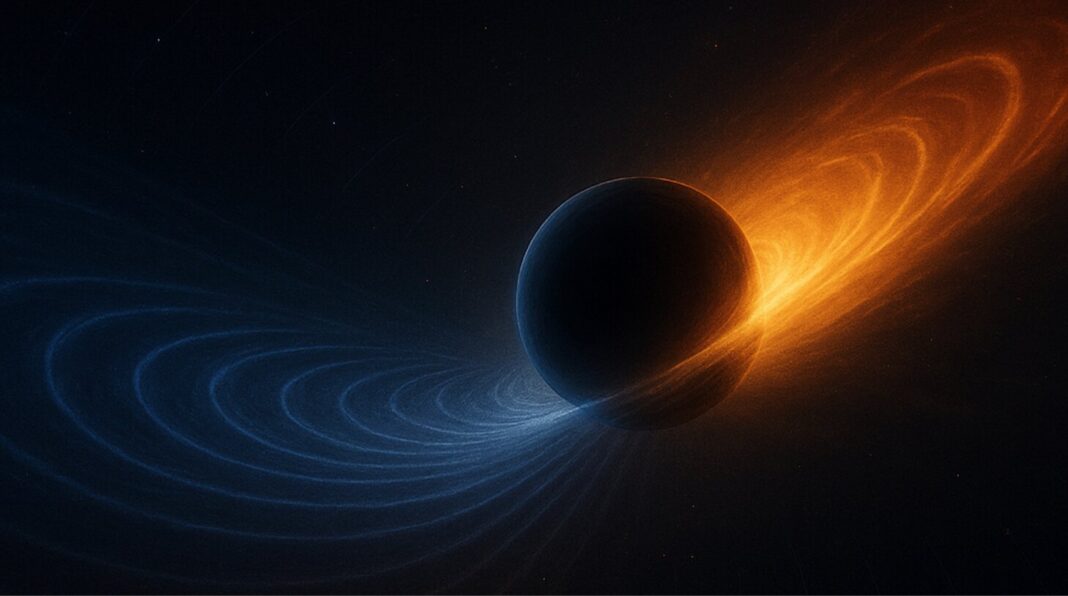A team of researchers led by the Instituto Galego de Física de Altas Enerxías (IGFAE) from the University of Santiago de Compostela (Spain) has measured for the first time the speed and direction of the recoil of a newborn black hole formed through the merger of two others. The result, published today in the journal Nature Astronomy, offers new insights into some of the most extreme events in the universe.
Gravitational waves (GWs) are ripples in the fabric of spacetime that travel away from their sources at the speed of light, encoding information about them. They provide a completely novel information channel that allows us to observe astrophysical phenomena that do not emit light—such as black hole mergers—and obtain new information about processes that do—such as supernovae or neutron-star mergers.
While Einstein predicted the existence of GWs in 1916, they are so weak that detecting them requires incredibly sensitive detectors and extremely violent astrophysical events such as black-hole mergers, supernovae or the Big Bang itself.
For this reason, it took a century to detect GWs for the first time, when the Advanced LIGO detectors—located in Hanford (Washington) and Livingston (Louisiana)—recorded in September 2015 the signal GW150914, emitted by the merger of two black holes of around 30 times the mass of the sun. Since then, almost 300 such events have been recorded, which has allowed us to start exploring the population of black holes in our universe and test gravity in its most violent regime.
Among the most dramatic outcomes of black hole mergers is the black hole recoil. When two black holes merge, the resulting single black hole emits gravitational waves unevenly in different directions. This imbalance causes the remnant to “kick” away—sometimes at speeds of thousands of kilometers per second, fast enough to escape its host galaxy.
Now, a decade after the first discovery of GWs, a small team of researchers from the University of Santiago de Compostela, Pennsylvania State University and The Chinese University of Hong Kong has measured for the first time both the speed and direction the recoiling black hole formed during the event GW190412: a merger of two black holes of unequal masses observed in 2019 by the Advanced LIGO and Virgo detectors during their third observing period.
Measuring a black-hole recoil
Gravitational waves emitted in different directions look very different, which allows us to understand where exactly we are around the source. Therefore, signals differ significantly depending on the observer’s position relative to the recoil, which allows us to know its direction with respect to that defined by the source and Earth. In addition, GR tells us the speed of the recoil given the measurements of the masses and spins of the source. With this we can completely characterize the recoil.
Prof. Juan Calderon-Bustillo, IGFAE researcher and leading author, explains this with a music analogy: “Black-hole mergers can be understood as a superposition of different signals, just like the music of an orchestra consistent with the combination of music played by many different instruments. However, this orchestra is special: audiences located in different positions around it will record different combinations of instruments, which allows them to understand where exactly they are around it.”
The team concluded that the recoil of the remnant of GW190412 surpassed 50 km/s—enough to expel the black hole from a globular cluster—and determined its recoil direction with respect to Earth, the orbital angular momentum of the system, and the binary’s separation line a couple seconds before the merger.
“We came out with this method back in 2018. We showed it would enable kick measurements using our current detectors at a time when other existing methods required detectors like LISA, which was more than a decade away,” Calderon-Bustillo says.
“Unfortunately, by that time Advanced LIGO and Virgo had not detected a signal with ‘music from various instruments’ that could enable a kick measurement. However, we were sure one such detection should happen soon. It was extremely exciting to detect GW190412 just one year later, notice the kick could probably be measured, and actually do it.”
Dr. Koustav Chandra, postdoctoral researcher at Penn State says, “This is one of the few phenomena in astrophysics where we’re not just detecting something—we’re reconstructing the full 3D motion of an object that’s billions of light-years away, using only ripples in spacetime. It’s a remarkable demonstration of what gravitational waves can do.”
And what comes next?
Measuring the direction of black-hole recoils can open avenues to study black-hole mergers with both gravitational and electromagnetic signals.
“Black-hole mergers in dense environments can lead to detectable electromagnetic signals—known as flares—as the remnant black hole traverses a dense environment like an active galactic nucleus (AGN)” says Samson Leong, Ph.D student at the Chinese University of Hong Kong and co-author of the article.
“Because the visibility of the flare depends on the recoil’s orientation relative to Earth, measuring the recoils will allow us to distinguish between a true GW-EM signal pair that comes from a BBH and a just random coincidence.”
More information:
Nature Astronomy (2025). www.nature.com/articles/s41550-025-02632-5
Provided by
Galician Institute of High Energy Physics
Citation:
First-ever complete measurement of a black-hole recoil achieved thanks to gravitational waves (2025, September 9)
retrieved 9 September 2025
from https://phys.org/news/2025-08-black-hole-recoil-gravitational.html
This document is subject to copyright. Apart from any fair dealing for the purpose of private study or research, no
part may be reproduced without the written permission. The content is provided for information purposes only.

